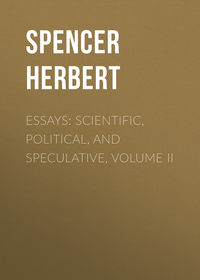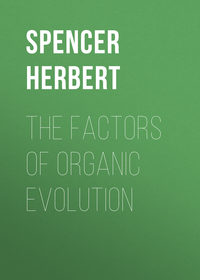
Полная версия
Principles of Sociology
Next come the changes wrought in the kinds and quantities of plant-life over the surface occupied. These changes are three-fold. There is the increasing culture of plants conducive to social growth, replacing plants not conducive to it; there is the gradual production of better varieties of these useful plants, causing, in time, great divergences from their originals; and there is, eventually, the introduction of new useful plants.
Simultaneously go on the kindred changes which social progress works in the Fauna of the region. We have the diminution or destruction of some or many injurious species. We have the fostering of useful species, which has the double effect of increasing their numbers and making their qualities more advantageous to society. Further, we have the naturalization of desirable species brought from abroad.
It needs but to think of the immense contrast between a wolf-haunted forest or a boggy moor peopled with wild birds, and the fields covered with crops and flocks which eventually occupy the same area, to be reminded that the environment, inorganic and organic, of a society, undergoes a continuous transformation during the progress of the societv; and that this transformation becomes an all important secondary factor in social evolution.
§ 9.
Another secondary factor is the increasing size of the social aggregate, accompanied, generally, by increasing density.
Apart from social changes otherwise produced, there are social changes produced by simple growth. Mass is both a condition to, and a result of, organization. It is clear that heterogeneity of structure is made possible only by multiplicity of units. Division of labour cannot be carried far where there are but few to divide the labour among them. Complex co-operations, governmental and industrial, are impossible without a population large enough to supply many kinds and gradations of agents. And sundry developed forms of activity, both predatory and peaceful, are made practicable only by the power which large masses of men furnish.
Hence, then, a derivative factor which, like the rest, is at once a consequence and a cause of social progress, is social growth. Other factors co-operate to produce this; and this joins other factors in working further changes.
§ 10.
Among derived factors we may next note the reciprocal influence of the society and its units – the influence of the whole on the parts, and of the parts on the whole.
As soon as a combination of men acquires permanence, there begin actions and reactions between the community and each member of it, such that either affects the other in nature. The control exercised by the aggregate over its units, tends ever to mould their activities and sentiments and ideas into congruity with social requirements; and these activities, sentiments, and ideas, in so far as they are changed by changing circumstances, tend to re-mould the society into congruity with themselves.
In addition, therefore, to the original nature of the individuals and the original nature of the society they form, we have to take into account the induced natures of the two. Eventually, mutual modification becomes a potent cause of transformation in both.
§ 11.
Yet a further derivative factor of extreme importance remains. I mean the influence of the super-organic environment – the action and reaction between a society and neighbouring societies.
While there exist only small, wandering, unorganized hordes, the conflicts of these with one another work no permanent changes of arrangement in them. But when there have arisen the definite chieftainships which frequent conflicts tend to initiate, and especially when the conflicts have ended in subjugations, there arise the rudiments of political organization; and, as at first, so afterwards, the wars of societies with one another have all-important effects in developing social structures, or rather, certain of them. For I may here, in passing, indicate the truth to be hereafter exhibited in full, that while the industrial organization of a society is mainly determined by its inorganic and organic environments, its governmental organization is mainly determined by its super-organic environment – by the actions of those adjacent societies with which it carries on the struggle for existence.
§ 12.
There remains in the group of derived factors one more, the potency of which can scarcely be over-estimated. I mean that accumulation of super-organic products which we commonly distinguish as artificial, but which, philosophically considered, are no less natural than all other products of evolution. There are several orders of these.
First come the material appliances, which, beginning with roughly-chipped flints, end in the complex automatic tools of an engine-factory driven by steam; which from boomerangs rise to eighty-ton guns; which from huts of brandies and grass grow to cities with their palaces and cathedrals. Then we have language, able at first only to eke out gestures in communicating simple ideas, but eventually becoming capable of expressing involved conceptions with precision. While from that stage in which it conveys thoughts only by sounds to one or a few persons, we pass through picture-writing up to steam-printing: multiplying indefinitely the numbers communicated with, and making accessible in voluminous literatures the ideas and feelings of countless men in various places and times. Concomitantly there goes on the development of knowledge, ending in science. Numeration on the lingers grows into far-reaching mathematics; observation of the moon's changes leads in time to a theory of the solar system; and there successively arise sciences of which not even the germs could at first be detected.
Meanwhile the once few and simple customs, becoming more numerous, definite, and fixed, end in systems of laws. Rude superstitions initiate elaborate mythologies, theologies, cosmogonies. Opinion getting embodied in creeds, gets embodied, too, in accepted codes of ceremony and conduct, and in established social sentiments. And then there
slowly evolve also the products we call aesthetic; which of themselves form a highly-complex group. From necklaces of fishbones we advance to dresses elaborate, gorgeous, and infinitely varied; out of discordant war-chants come symphonies and operas; cairns develop into magnificent temples; in place of caves with rude markings there arise at length galleries of paintings; and the recital of a chiefs deeds with mimetic accompaniment gives origin to epics, dramas, lyrics, and the vast mass of poetry, fiction, biography, and history.
These various orders of super-organic products, each developing within itself new genera and species while growing into a larger whole, and each acting on the other orders while reacted on by them, constitute an immensely-voluminous, immensely-complicated, and immensely-powerful set of influences. During social evolution they are ever modifying individuals and modifying society, while being modified by both. They gradually form what we may consider either as a non-vital part of the society itself, or else as a secondary environment, which eventually becomes more important than the primary environments – so much more important that there arises the possibility of carrying on a high kind of social life under inorganic and organic coalitions which originally would have prevented it.
§ 13.
Such are the factors in outline. Even when presented under this most general form, the combination of them is seen to be of an involved kind.
Recognizing the primary truth that social phenomena depend in part on the natures of the individuals and in part on the forces the individuals are subject to, we see that these two fundamentally-distinct sets of factors, with which social changes commence, give origin to other sets as social changes advance. The pre-established environing influences, inorganic and organic, which are at first almost unalterable, become more and more altered by the actions of the evolving society. Simple growth of population brings into play fresh causes of transformation that are increasingly important. The influences which the society exerts on the natures of its units, and those which the units exert on the nature of the society, incessantly co-operate in creating new elements. As societies progress in size and structure, they work on one another, now by their war-struggles and now by their industrial intercourse, profound metamorphoses. And the ever-accumulating, ever-complicating super-organic products, material and mental, constitute a further set of factors which become more and more influential causes of change. So that, involved as the factors are at the beginning, each step in advance increases the involution, by adding factors which themselves grow more complex while they grow more powerful.
But now having glanced at the factors of all orders, original and derived, we must neglect for the present those which are derived, and attend exclusively, or almost exclusively, to those which are original. The Data of Sociology, here to be dealt with, we must, as far as possible, restrict to those primary data common to social phenomena in general, and most readily distinguished in the simplest societies. Adhering to the broad division made at the outset between the extrinsic and intrinsic co-operating causes, we will consider first the extrinsic.
1 It is worth noting that drainage increases what we may figuratively call terrestrial respiration; and that on terrestrial respiration the lives of land-plants, and therefore of land-animals, and therefore of men, depend. Every change of atmospheric, pressure produces exits or entrances of the air into all the interstices of the soil. The depth to which these irregular inspirations and expirations reach, is increased by freedom from water; since interstices occupied by water cannot be filled by air. Thus those chemical decompositions effected by the air that is renewed with every fall and rise of the barometer, are extended to a greater depth by drainage; and the plant-life depending on such decompositions is facilitated.
III. ORIGINAL EXTERNAL FACTORS.
§ 14.
A COMPLETE outline of the original external factors implies a knowledge of the past which we have not got, and are not likely to get. Now that geologists and archaeologists are uniting to prove that human existence goes back to a time so remote that «pre-historic» scarcely expresses it, we are shown that the effects of external conditions on social evolution cannot be fully traced. Remembering that the 20,000 years, or so, during which man has lived in the Nile-valley, is made to seem a relatively-small period by the evidence that he coexisted with the extinct mammals of the drift – remembering that England had human inhabitants at an epoch which good judges think was glacial – remembering that in America, along with the bones of a Mastodon imbedded, in the alluvium of the Bourbense, were found arrowheads and other traces of the savages who had killed this member of an order no longer represented in that part of the world – remembering that, judging from the evidence as interpreted by Professor Huxley, those vast subsidences which changed a continent into the Eastern Archipelago, took place after the Negro-race was established as a distinct variety of man; we must infer that it is hopeless to trace back the external factors of social phenomena to anything like their first forms.
One important truth only, implied by the evidence thus glanced at, must be noted. Geological changes and meteorological changes, as well as the consequent changes of Floras and Faunas, must have been causing, over all parts of the Earth, perpetual emigrations and immigrations. From each locality made less habitable by increasing inclemency, a wave of diffusion must have spread; into each locality made more favourable to human existence by amelioration of climate, or increase of indigenous food, or both, a wave of concentration must have been set up; and by great geological changes, here sinking areas of land and there raising areas, other redistributions of mankind must have been produced. Accumulating facts show that these enforced ebbings and flowings have, in some localities, and probably in most, taken place time after time. And such waves of emigration and immigration must have been ever bringing the dispersed groups of the race into contact with conditions more or less new.
Carrying with us this conception of the way in which the external factors, original in the widest sense, have cooperated throughout all past time, we must limit our attention to such effects of them as we have now before us.
§ 15.
Life in general is possible only between certain limits of temperature; and life of the higher kinds is possible only within a comparatively-narrow range of temperature, maintained artificially if not naturally. Hence social life, presupposing as it does not only human life but that life vegetal and animal on which human life depends, is restricted by certain extremes of cold and heat.
Cold, though great, does not rigorously exclude warmblooded creatures, if the locality supplies adequate means of generating heat. The arctic regions contain various marine and terrestrial mammals, large and small; but the existence of these depends, directly or indirectly, on the existence of the inferior marine creatures, vertebrate and invertebrate, which would cease to live there did not the warm currents from the tropics check the formation of ice. Hence such human life as we find in the far north, dependent as it is mainly on the life of these mammals, is also remotely dependent on the same source of heat. But where, as in such places, the temperature which man's vital functions require can be maintained with difficulty, social evolution is not possible. There can be neither a sufficient surplus-power in each individual nor a sufficient number of individuals. Not only are the energies of an Esquimaux expended mainly in guarding against loss of heat, but his bodily functions are greatly modified to the same end. Without fuel, and, indeed, unable to burn within his snow-hut anything more than an oil-lamp, lest the walls should melt, he has to keep up that warmth which even his thick fur-dress fails to retain, by devouring vast quantities of blubber and oil; and his digestive system, heavily taxed in providing the wherewith to meet excessive loss by radiation, supplies less material for other vital purposes. This great physiological cost of individual life, indirectly checking the multiplication of individuals, arrests social evolution. A kindred relation of cause and effect is shown us in the Southern hemisphere by the still-more-miserable Puegians. Living nearly unclothed in a region of storms, which their wretched dwellings of sticks and grass do not exclude, and having little food but fish and mollusks, these beings, described as scarcely human in appearance, have such difficulty in preserving the vital balance in face of the rapid escape of heat, that the surplus for individual development is narrowly restricted, and, consequently, the surplus for producing and rearing new individuals. Hence the numbers remain too small for exhibiting anything beyond incipient social existence.
Though, in some tropical regions, an opposite extreme of temperature so far impedes the vital actions as to impede social development, yet hindrance from this cause seems exceptional and relatively unimportant. Life in general, and mammalian life along with it, is great in quantity as well as individually high, in localities that are among the hottest. The silence of the forests during the noontide glare in such localities, does, indeed, furnish evidence of enervation; but in cooler parts of the twenty-four hours there is a compensating energy. And if varieties of the human race adapted to these localities, show, in comparison with ourselves, some indolence, this does not seem greater than, or even equal to, the indolence of the primitive man in temperate climates. Contemplated in the mass, facts do not countenance the current idea that great heat hinders progress. All the earliest recorded civilizations belonged to regions which, if not tropical, almost equal the tropics in height of temperature. India and Southern China, as still existing, show us great social evolutions within the tropics. The vast architectural remains of Java and of Cambodia yield proofs of other tropical civilizations in the East; while the extinct societies of Central America, Mexico, and Peru, need but be named to make it manifest that in the New World also, there were in past times great advances in hot regions. It is thus, too, if we compare societies of ruder types that have developed in warm climates, with allied societies belonging to colder climates. Tahiti, the Tonga Islands, and the Sandwich Islands, are within the tropics; and in them, when first discovered, there had been reached stages of evolution which were remarkable considering the absence of metals.
I do not ignore the fact that in recent times societies have evolved most, both in size and complexity, in temperate regions. I simply join with this the fact that the first considerable societies arose, and the primary stages of social development were reached, in hot climates. The truth would seem to be that the earlier phases of progress had to be passed through where the resistances offered by inorganic conditions were least; that when the arts of life had been advanced, it became possible for societies to develop in regions where the resistances were greater; and that further developments in the arts of life, with the further discipline in co-operation accompanying them, enabled subsequent societies to take root and grow in regions which, by climatic and other conditions, offered relatively-great resistances.
We must therefore say that solar radiation, being the source of those forces by which life, vegetal and animal, is carried on; and being, by implication, the source of the forces displayed in human life, and consequently in social life; it results that there can be no considerable social evolution on tracts of the Earth's surface where solar radiation is very feeble. Though, contrariwise, there is on some tracts a solar radiation in excess of the degree most favourable to vital actions; yet the consequent hindrance to social evolution is relatively small. Further, we conclude that an abundant supply of light and heat is especially requisite during those first stages of progress in which social vitality is small.
§ 16.
Passing over such traits of climate as variability and equability, whether diurnal, annual, or irregular, all of which have their effects on human activities, and therefore on social phenomena, I will name one other climatic trait that appears to be an important factor. I refer to the quality of the air in respect of dryness or moisture.
Either extreme brings indirect impediments to civilization, which we may note before observing the direct effects. That great dryness of the air, causing a parched surface and a scanty vegetation, negatives the multiplication needed for advanced social life, is a familiar fact. And it is a fact, though not a familiar one, that extreme humidity, especially when joined with great heat, may raise unexpected obstacles to progress; as, for example, in parts of East Africa, where «the springs of powder-flasks exposed to the damp snap like toasted quills; ... paper, becoming soft and soppy by the loss of glazing, acts as a blotter ... metals are ever rusty ... and gunpowder, if not kept from the air, refuses to ignite.»
But it is the direct effects of different hygrometric states, which are most noteworthy – the effects on the vital processes. and, therefore, on the individual activities, and, through them, on the social activities. Bodily functions are facilitated by atmospheric conditions which make evaporation from the skin and lungs rapid. That weak persons, whose variations of health furnish good tests, are worse when the air is surcharged with water, and are better when the weather is fine; and that commonly such persons are enervated by residence in moist localities but invigorated by residence in dry ones, are facts generally recognized. And this relation of cause and effect, manifest in individuals, doubtless holds in races. Throughout temperate regions, differences of constitutional activity due to differences of atmospheric humidity, are less traceable than in torrid regions: the reason being that all the inhabitants are subject to a tolerably quick escape of water from their surfaces; since the air, though well charged with water, will take up more when its temperature, previously low, is raised by contact with the body. But it is otherwise in tropical regions where the body and the air bathing it differ much less in temperature; and where, indeed, the air is sometimes higher in temperature than the body. Here the rate of evaporation depends almost wholly on the quantity of surrounding vapour. If the air is hot and moist, the escape of water through the skin and lungs is greatly hindered; while it is greatly facilitated if the air is hot and dry. Hence in the torrid zone, we may expect constitutional differences between the inhabitants of low steaming tracts and the inhabitants of tracts parched with heat. Needful as are cutaneous and pulmonary evaporation for maintaining the movement of fluids through the tissues and thus furthering molecular changes, it is to be inferred that, other things equal, there will be more bodily activity in the people of hot and dry localities than in the people of hot and humid localities.
The evidence justifies this inference. The earliest-recorded civilization grew up in a hot and dry region – Egypt; and in hot and dry regions also arose the Babylonian, Assyrian, and Phoenician civilizations. But the facts when stated in terms of nations are far less striking than when stated in terms of races. On glancing over a general rain-map, there will be seen an almost-continuous area marked «rainless district», extending across North Africa, Arabia, Persia, and on through Thibet into Mongolia; and from within, or from the borders of, this district, have come all the conquering races of the Old World. We have the Tartar race, which, passing the Southern mountain-boundary of this rainless district, peopled China and the regions between it and India – thrusting the aborigines of these areas into the hilly tracts; and which has sent successive waves of invaders not into these regions only, but into the West. We have the Aryan race, overspreading India and making its way through Europe. We have the Semitic race, becoming dominant in North Africa, and, spurred on by Mahommedan fanaticism, subduing parts of Europe. That is to say, besides the Egyptian race, which became powerful in the hot and dry valley of the Nile, we have three races widely unlike in type, which, from different parts of the rainless district have spread over regions relatively humid. Original superiority of type was not the common trait of these peoples: the Tartar type is inferior, as was the Egyptian. But the common trait, as proved by subjugation of other peoples, was energy. And when we see that this common trait in kinds of men otherwise unlike, had for its concomitant their long-continued subjection to these special climatic conditions – when we find, further, that from the region characterized by these conditions, the earlier waves of conquering emigrants, losing in moister countries their ancestral energy, were over-run by later waves of the same kind of men, or of other kinds, coming from this region; we get strong reason for inferring a relation between constitutional vigour and the presence of an air which, by its warmth and dryness, facilitates the vital actions. A striking verification is at hand. The rain-map of the New World shows that the largest of the parts distinguished as almost rainless, is that Central-American and Mexican region in which indigenous civilizations developed; and that the only other rainless district is that part of the ancient Peruvian territory, in which the pre-Ynca civilization has left its most conspicuous traces. Inductively, then, the evidence justifies in a remarkable manner the physiological deduction. Nor are there wanting minor verifications. Speaking of the varieties of negroes, Livingstone says – «Heat alone does not produce blackness of skin, but heat with moisture seems to insure the deepest hue»; and Schweinfurth remarks on the relative blackness of the Denka and other tribes living on the alluvial plains, and contrasts them with «the less swarthy and more robust races who inhabit the rocky hills of the interior»: differences with which there go differences of energy. But I note this fact for the purpose of suggesting its probable connexion with the fact that the lighter-skinned, races are habitually the dominant races. We see it to have been so in Egypt. It was so with the races spreading south from Central Asia. Traditions imply that it was so in Central America and Peru. Speke says: – «I have always found the lighter-coloured savages more boisterous and warlike than those of a dingier hue.» And if, heat being the same, darkness of skin accompanies humidity of the air, while lightness of skin accompanies dryness of the air, then, in this habitual predominance of the fair varieties of men, we find further evidence that constitutional activity, and in so far social development, is favoured by a climate conducing to rapid evaporation.











